Yukun Zhao
DiffuGR: Generative Document Retrieval with Diffusion Language Models
Nov 19, 2025Abstract:Generative retrieval (GR) re-frames document retrieval as a sequence-based document identifier (DocID) generation task, memorizing documents with model parameters and enabling end-to-end retrieval without explicit indexing. Existing GR methods are based on auto-regressive generative models, i.e., the token generation is performed from left to right. However, such auto-regressive methods suffer from: (1) mismatch between DocID generation and natural language generation, e.g., an incorrect DocID token generated in early left steps would lead to totally erroneous retrieval; and (2) failure to balance the trade-off between retrieval efficiency and accuracy dynamically, which is crucial for practical applications. To address these limitations, we propose generative document retrieval with diffusion language models, dubbed DiffuGR. It models DocID generation as a discrete diffusion process: during training, DocIDs are corrupted through a stochastic masking process, and a diffusion language model is learned to recover them under a retrieval-aware objective. For inference, DiffuGR attempts to generate DocID tokens in parallel and refines them through a controllable number of denoising steps. In contrast to conventional left-to-right auto-regressive decoding, DiffuGR provides a novel mechanism to first generate more confident DocID tokens and refine the generation through diffusion-based denoising. Moreover, DiffuGR also offers explicit runtime control over the qualitylatency tradeoff. Extensive experiments on benchmark retrieval datasets show that DiffuGR is competitive with strong auto-regressive generative retrievers, while offering flexible speed and accuracy tradeoffs through variable denoising budgets. Overall, our results indicate that non-autoregressive diffusion models are a practical and effective alternative for generative document retrieval.
Joint Flashback Adaptation for Forgetting-Resistant Instruction Tuning
May 21, 2025Abstract:Large language models have achieved remarkable success in various tasks. However, it is challenging for them to learn new tasks incrementally due to catastrophic forgetting. Existing approaches rely on experience replay, optimization constraints, or task differentiation, which encounter strict limitations in real-world scenarios. To address these issues, we propose Joint Flashback Adaptation. We first introduce flashbacks -- a limited number of prompts from old tasks -- when adapting to new tasks and constrain the deviations of the model outputs compared to the original one. We then interpolate latent tasks between flashbacks and new tasks to enable jointly learning relevant latent tasks, new tasks, and flashbacks, alleviating data sparsity in flashbacks and facilitating knowledge sharing for smooth adaptation. Our method requires only a limited number of flashbacks without access to the replay data and is task-agnostic. We conduct extensive experiments on state-of-the-art large language models across 1000+ instruction-following tasks, arithmetic reasoning tasks, and general reasoning tasks. The results demonstrate the superior performance of our method in improving generalization on new tasks and reducing forgetting in old tasks.
Improving the Robustness of Large Language Models via Consistency Alignment
Mar 22, 2024



Abstract:Large language models (LLMs) have shown tremendous success in following user instructions and generating helpful responses. Nevertheless, their robustness is still far from optimal, as they may generate significantly inconsistent responses due to minor changes in the verbalized instructions. Recent literature has explored this inconsistency issue, highlighting the importance of continued improvement in the robustness of response generation. However, systematic analysis and solutions are still lacking. In this paper, we quantitatively define the inconsistency problem and propose a two-stage training framework consisting of instruction-augmented supervised fine-tuning and consistency alignment training. The first stage helps a model generalize on following instructions via similar instruction augmentations. In the second stage, we improve the diversity and help the model understand which responses are more aligned with human expectations by differentiating subtle differences in similar responses. The training process is accomplished by self-rewards inferred from the trained model at the first stage without referring to external human preference resources. We conduct extensive experiments on recent publicly available LLMs on instruction-following tasks and demonstrate the effectiveness of our training framework.
Automating Psychological Hypothesis Generation with AI: Large Language Models Meet Causal Graph
Feb 22, 2024Abstract:Leveraging the synergy between causal knowledge graphs and a large language model (LLM), our study introduces a groundbreaking approach for computational hypothesis generation in psychology. We analyzed 43,312 psychology articles using a LLM to extract causal relation pairs. This analysis produced a specialized causal graph for psychology. Applying link prediction algorithms, we generated 130 potential psychological hypotheses focusing on `well-being', then compared them against research ideas conceived by doctoral scholars and those produced solely by the LLM. Interestingly, our combined approach of a LLM and causal graphs mirrored the expert-level insights in terms of novelty, clearly surpassing the LLM-only hypotheses (t(59) = 3.34, p=0.007 and t(59) = 4.32, p<0.001, respectively). This alignment was further corroborated using deep semantic analysis. Our results show that combining LLM with machine learning techniques such as causal knowledge graphs can revolutionize automated discovery in psychology, extracting novel insights from the extensive literature. This work stands at the crossroads of psychology and artificial intelligence, championing a new enriched paradigm for data-driven hypothesis generation in psychological research.
HR-APR: APR-agnostic Framework with Uncertainty Estimation and Hierarchical Refinement for Camera Relocalisation
Feb 22, 2024



Abstract:Absolute Pose Regressors (APRs) directly estimate camera poses from monocular images, but their accuracy is unstable for different queries. Uncertainty-aware APRs provide uncertainty information on the estimated pose, alleviating the impact of these unreliable predictions. However, existing uncertainty modelling techniques are often coupled with a specific APR architecture, resulting in suboptimal performance compared to state-of-the-art (SOTA) APR methods. This work introduces a novel APR-agnostic framework, HR-APR, that formulates uncertainty estimation as cosine similarity estimation between the query and database features. It does not rely on or affect APR network architecture, which is flexible and computationally efficient. In addition, we take advantage of the uncertainty for pose refinement to enhance the performance of APR. The extensive experiments demonstrate the effectiveness of our framework, reducing 27.4\% and 15.2\% of computational overhead on the 7Scenes and Cambridge Landmarks datasets while maintaining the SOTA accuracy in single-image APRs.
VisLingInstruct: Elevating Zero-Shot Learning in Multi-Modal Language Models with Autonomous Instruction Optimization
Feb 12, 2024Abstract:This paper presents VisLingInstruct, a novel approach to advancing Multi-Modal Language Models (MMLMs) in zero-shot learning. Current MMLMs show impressive zero-shot abilities in multi-modal tasks, but their performance depends heavily on the quality of instructions. VisLingInstruct tackles this by autonomously evaluating and optimizing instructional texts through In-Context Learning, improving the synergy between visual perception and linguistic expression in MMLMs. Alongside this instructional advancement, we have also optimized the visual feature extraction modules in MMLMs, further augmenting their responsiveness to textual cues. Our comprehensive experiments on MMLMs, based on FlanT5 and Vicuna, show that VisLingInstruct significantly improves zero-shot performance in visual multi-modal tasks. Notably, it achieves a 13.1% and 9% increase in accuracy over the prior state-of-the-art on the TextVQA and HatefulMemes datasets.
MobileARLoc: On-device Robust Absolute Localisation for Pervasive Markerless Mobile AR
Feb 04, 2024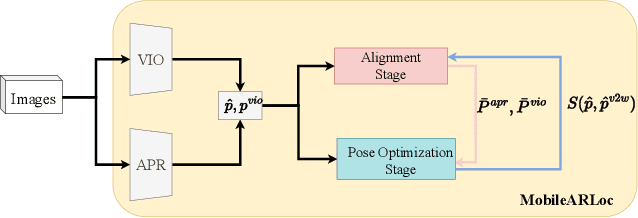



Abstract:Recent years have seen significant improvement in absolute camera pose estimation, paving the way for pervasive markerless Augmented Reality (AR). However, accurate absolute pose estimation techniques are computation- and storage-heavy, requiring computation offloading. As such, AR systems rely on visual-inertial odometry (VIO) to track the device's relative pose between requests to the server. However, VIO suffers from drift, requiring frequent absolute repositioning. This paper introduces MobileARLoc, a new framework for on-device large-scale markerless mobile AR that combines an absolute pose regressor (APR) with a local VIO tracking system. Absolute pose regressors (APRs) provide fast on-device pose estimation at the cost of reduced accuracy. To address APR accuracy and reduce VIO drift, MobileARLoc creates a feedback loop where VIO pose estimations refine the APR predictions. The VIO system identifies reliable predictions of APR, which are then used to compensate for the VIO drift. We comprehensively evaluate MobileARLoc through dataset simulations. MobileARLoc halves the error compared to the underlying APR and achieve fast (80\,ms) on-device inference speed.
Knowing What LLMs DO NOT Know: A Simple Yet Effective Self-Detection Method
Oct 27, 2023Abstract:Large Language Models (LLMs) have shown great potential in Natural Language Processing (NLP) tasks. However, recent literature reveals that LLMs generate nonfactual responses intermittently, which impedes the LLMs' reliability for further utilization. In this paper, we propose a novel self-detection method to detect which questions that a LLM does not know that are prone to generate nonfactual results. Specifically, we first diversify the textual expressions for a given question and collect the corresponding answers. Then we examine the divergencies between the generated answers to identify the questions that the model may generate falsehoods. All of the above steps can be accomplished by prompting the LLMs themselves without referring to any other external resources. We conduct comprehensive experiments and demonstrate the effectiveness of our method on recently released LLMs, e.g., Vicuna, ChatGPT, and GPT-4.
DiQAD: A Benchmark Dataset for End-to-End Open-domain Dialogue Assessment
Oct 25, 2023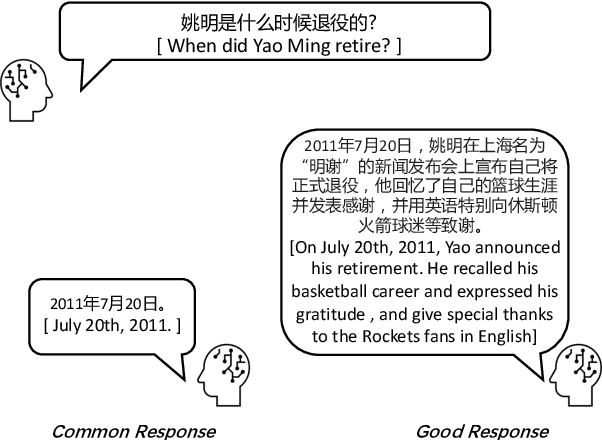
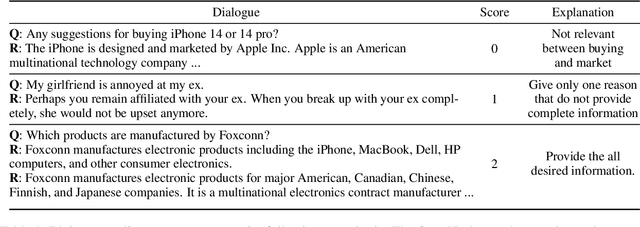
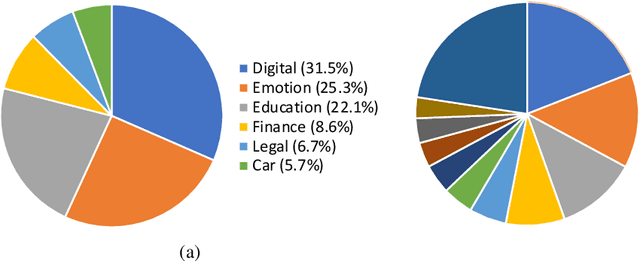
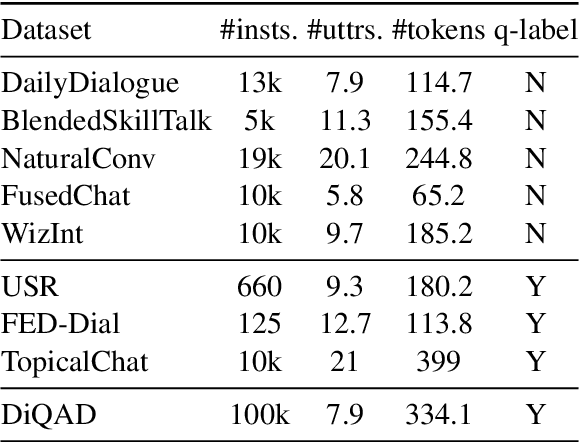
Abstract:Dialogue assessment plays a critical role in the development of open-domain dialogue systems. Existing work are uncapable of providing an end-to-end and human-epistemic assessment dataset, while they only provide sub-metrics like coherence or the dialogues are conversed between annotators far from real user settings. In this paper, we release a large-scale dialogue quality assessment dataset (DiQAD), for automatically assessing open-domain dialogue quality. Specifically, we (1) establish the assessment criteria based on the dimensions conforming to human judgements on dialogue qualities, and (2) annotate large-scale dialogues that conversed between real users based on these annotation criteria, which contains around 100,000 dialogues. We conduct several experiments and report the performances of the baselines as the benchmark on DiQAD. The dataset is openly accessible at https://github.com/yukunZhao/Dataset_Dialogue_quality_evaluation.
Robust Localization with Visual-Inertial Odometry Constraints for Markerless Mobile AR
Aug 10, 2023Abstract:Visual Inertial Odometry (VIO) is an essential component of modern Augmented Reality (AR) applications. However, VIO only tracks the relative pose of the device, leading to drift over time. Absolute pose estimation methods infer the device's absolute pose, but their accuracy depends on the input quality. This paper introduces VIO-APR, a new framework for markerless mobile AR that combines an absolute pose regressor (APR) with a local VIO tracking system. VIO-APR uses VIO to assess the reliability of the APR and the APR to identify and compensate for VIO drift. This feedback loop results in more accurate positioning and more stable AR experiences. To evaluate VIO-APR, we created a dataset that combines camera images with ARKit's VIO system output for six indoor and outdoor scenes of various scales. Over this dataset, VIO-APR improves the median accuracy of popular APR by up to 36\% in position and 29\% in orientation, increases the percentage of frames in the high ($0.25 m, 2^{\circ}$) accuracy level by up to 112\% and reduces the percentage of frames predicted below the low ($5 m, 10^\circ$) accuracy greatly. We implement VIO-APR into a mobile AR application using Unity to demonstrate its capabilities. VIO-APR results in noticeably more accurate localization and a more stable overall experience.
 Add to Chrome
Add to Chrome Add to Firefox
Add to Firefox Add to Edge
Add to Edge